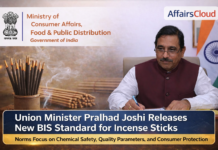 The Reserve Bank of India’s (RBI) 6-members Monetary Policy Committee (MPC) had met on 6th, 7th and 8th October 2021 and released its fourth bi-monthly monetary policy statement for FY22 (April 2021 – March 2022).
The Reserve Bank of India’s (RBI) 6-members Monetary Policy Committee (MPC) had met on 6th, 7th and 8th October 2021 and released its fourth bi-monthly monetary policy statement for FY22 (April 2021 – March 2022).
Policy Rates:
RBI kept the rates unchanged (maintains status quo) for the 8th consecutive time i.e it decided to continue with the accommodative stance to mitigate the impact of COVID-19 on the economy and to revive and sustain growth on a durable basis while ensuring that inflation remains within the target going forward.
The unchanged Policy rates are as follows:
| Category | Rates |
|---|---|
| Policy Rates | |
| Policy Repo Rate | 4.00% |
| Reverse Repo Rate | 3.35% |
| Marginal Standing Facility (MSF) Rate | 4.25% |
| Bank Rate | 4.25% |
| Reserve Ratios | |
| Cash Reserve Ratio (CRR) | 4.00% |
| Statutory Liquidity Ratio (SLR) | 18.00% |
About Monetary Policy Stances:
Monetary Policy Stances of RBI are classified into Dovish, Hawkish, Accommodative, and Neutral.
Hawkish stance: This monetary policy stance supports high interest rates to keep inflation in check. Because of the high interest rates, borrowing i.e. taking loans from banks and other sources will be reduced.
Dovish: It is a stance opposite to the Hawkish stance and this monetary policy stance involves low-interest rates. Low-Interest Rates would induce the consumers to take loans from Banks.
Accommodative: This stance will be used to allow the money supply to rise in line with national income and the demand for money.
- RBI will use the accommodative stance to expand the overall money supply to boost the economy when the economic growth is slowing down.
Neutral: In this stance, the Key Policy Rates are neither increased nor decreased.
a.MPC’s Assessments on growth and inflation:
-Growth
The MPC has retained India’s real gross domestic product (GDP) growth projection for FY22 at 9.5 percent with 7.9 percent in Q2; 6.8 percent in Q3; and 6.1 percent in Q4 of 2021-22.
- Real GDP growth for Q1 FY23 is projected at 17.2 per cent.
-Inflation
i.Consumer Price Index (CPI) inflation was projected at 5.3 percent in FY22, with 5.1 percent in Q2; 4.5 percent in Q3; and 5.8 percent in Q4.
ii.CPI inflation for Q1 FY23 was projected at 5.2 percent.
iiI.The government retained the inflation target at 4 percent with the lower and upper tolerance levels of 2 percent and 6 percent, i.e. within a band of +/- 2 percent.
Member of MPC:
The MPC meeting was headed by RBI Governor Shaktikanta Das the other 5 members of the committee include,
- Shashanka Bhide, Ashima Goyal, Prof. Jayanth R. Varma, Mridul K. Saggar, and Michael Debabrata Patra
b.MPC’ Liquidity Measures:
-RBI extended the deadline of on tap SLTRO for SFBs till December 31, 2021
Reserve Bank of India (RBI) decided to extend the on tap Special Long-Term Repo Operations (SLTRO) facility for small finance banks (SFBs) till December 31, 2021.
i.RBI conducted a special three-year SLTRO of Rs 10,000 crore at repo rate for the SFBs, to make fresh lending of up to Rs 10 lakh per borrower. The facility will be made available till October 31, 2021.
ii.All SFBs that are eligible under the Liquidity Adjustment Facility (LAF) are allowed to participate in the SLTRO scheme.
-RBI Plans to Introduce Digital Payment Solutions in Offline Mode
RBI proposed to introduce a framework for carrying out retail digital payments using mobile phones, cards, wallets, etc. in offline mode across India, especially in remote areas.
i.Background: In August 2020 at Statement on Development and Regulatory Policies, RBI announced a scheme to conduct pilot tests of innovative technology that enables retail digital payments using even in situations where internet connectivity is low / not available (offline mode) till March 31, 2021.
ii.So far 3 pilot schemes were successfully conducted in different parts of India from September 2020 to June 2021 involving small-value transactions using cards and wallets covering a volume of 2.41 lakh for a value of Rs 1.16 crore through offline mode.
iii.Guidelines of Pilot Schemes:
- Under the pilot scheme, payment system operators (PSO) – banks and non-banks were enabled to offer digital payments offline.
- The upper limit of a payment transaction should be Rs 200 and the total limit for offline transactions on an instrument should be Rs 2,000, at any point of time.
- Payment transactions were allowed to be offered without any Additional Factor of Authentication (AFA).
-RBI Enhanced Transaction Limit in IMPS from Rs 2 lakh to Rs 5 lakh
RBI proposed to increase the per-transaction limit in Immediate Payment Service (IMPS) from Rs 2 lakh (effective from January 2014) to Rs 5 lakh for channels other than SMS (short message service) and Interactive Voice Response System (IVRS).
- With RTGS (Real-Time Gross Settlement) now being operational round the clock, there has been a corresponding increase in settlement cycles of IMPS, the transaction limit was increased to improve the digital payments and provide an additional facility to customers for making digital payments beyond Rs 2 lakh.
- The per-transaction limit for SMS and IVRS channels is Rs 5000.
About IMPS:
i.IMPS, which is offered by the National Payments Corporation of India (NPCI) from 22nd November 2010, is a real-time payment service that empowers customers to transfer money round the clock (24X7) instantly through banks and RBI authorized Prepaid Payment Instrument Issuers (PPIs) across India.
ii.It is accessible through various channels like internet banking, mobile banking apps, bank branches, ATMs, SMS and IVRS.
-RBI Proposed Geo-tagging of Payment System Touch Points
i.RBI proposed setting up of a framework for geo-tagging (capturing geographical coordinates – viz., latitude and longitude) of physical payment acceptance infrastructure such as Point of Sale (PoS) terminals, Quick Response (QR) codes, etc., used by merchants to find out location information of existing payment acceptance infrastructure.
ii.The geo-tagging technology will provide location information on an ongoing basis and can be used in targeting areas that lag behind in payments acceptance infrastructure to ensure a balanced spread of acceptance infrastructure across the length and breadth of India.
iii.The setting up of the Payments Infrastructure Development Fund (PIDF) to encourage the deployment of acceptance infrastructure and create additional touch points is a step in this direction.
About Geo-tagging:
i.Geo tagging is a process of assigning a ‘geo-tag’ or adding some ‘geographical information’ in various ‘media’ forms such as a digital photograph, video, SMS, QR Codes, etc.
ii.The Geo-tag will generally contain latitude and longitude coordinates, they could also include altitude, distance, accuracy data, and place names.
Note – The 1st scheme that experimented with geo-tagging was the Mahatma Gandhi National Rural Employment Guarantee Act (MGNREGA), the rural jobs scheme that provides 100 days of employment every year to each village household.
RBI Announced 4th Sandbox Cohort on ‘Prevention and Mitigation of Financial Frauds’
RBI has announced the 4th sandbox cohort with the theme of ‘prevention and mitigation of financial frauds’ to provide a further boost to the fintech ecosystem.
i.Focus: Using technology to reduce the lag between the occurrence and detection of frauds, strengthening the fraud governance structure and minimising response time to frauds.
ii.RBI’s Regulatory Sandbox (RS) has so far introduced 3 cohorts on Retail Payments; Cross Border Payments; and MSME Lending.
- 6 entities have successfully exited the 1st Cohort on ‘Retail Payments’ while under the 2nd Cohort 8 entities are undertaking Tests, whereas, the application window for the Third Cohort is currently open.
iii.RBI also proposed to facilitate the ‘On Tap’ application for themes of cohorts that were closed earlier.
What is a Regulatory sandbox?
i.It usually refers to live testing of new products or services in a controlled regulatory environment for which regulators may (or may not) permit certain relaxations for the limited purpose of the testing.
ii.The objective of the regulatory sandbox is to foster responsible innovation in financial services, promote efficiency and bring benefit to consumers.
iii.It also allows the regulator, innovators, financial service providers and customers to conduct field tests regarding the benefits and risks of new financial innovations.
-RBI Extend the WMA for states till March 31, 2022
RBI has extended the interim enhancement of Ways and Means Advance (WMA) limits of Rs 51,560 Crore up to March 31, 2022.
i.Background: As per the recommendations of the Advisory Committee (Chairman: Shri Sudhir Shrivastava) to review the WMA limits for State Governments/Union Territories (UTs), in April 2021, due to the prevalence of the COVID-19, RBI has extended the interim WMA limit of Rs 51,560 crore for all states and UTs for 6 months i.e. up to September 30, 2021. Click here to know more
ii.RBI decided to extend the relaxations provided for the Overdraft facility (OD) for 6 months, i.e. up to March 31, 2022, to provide greater flexibility to States to manage their mismatches in cash flows.
iii.The number of consecutive days on which a State Government/UTs could avail was increased from 14 days to 21 days and the maximum number of days in a quarter on which the State Government/UTs can be in OD was increased from 36 days to 50 days.
Increased Regulations over NBFCs
-RBI Decided to Introduce IOS for NBFCs
RBI decided to introduce the Internal Ombudsman Scheme (IOS) for certain categories of NBFCs (Non-Banking Finance Companies) that have higher customer interface to strengthen the internal grievance redress mechanism of NBFCs.
i.The IOS for NBFCs will require NBFCs to appoint an Internal Ombudsman (IO) at the top of their internal grievance redress mechanism to examine customer complaints that are in the nature of deficiency in service and are partly or wholly rejected by the NBFCs.
ii.The IOS for NBFCs will be on the lines of IOS for banks and non-bank payment system participants.
-RBI Extended PSL by Banks to NBFCs up to March 31, 2021
RBI decided to extend lending of Banks to NBFCs for on-lending under the Priority Sector Lending (PSL) facility till March 31, 2022.
Background:
i.To boost credit among small and needy borrowers, on August 13, 2019 RBI allowed banks to classify their lending to registered NBFCs (other than MFIs) as PSL which was about 5% of a bank’s total PSL (for on-lending to Agriculture/MSME/Housing) till March 31, 2020, and later the facility was extended up to March 31, 2021.
ii.On April 7, 2021, the RBI extended the classified lending of Banks to NBFCs for on-lending under the Priority Sector Lending (PSL) up to September 30, 2021.
Key Points:
i.RBI has injected Rs 2.37 Lakh Crore liquidity into the financial system through Open Market Operations, in the first 6 months (first half-yearly (H1)) of FY22 against Rs 3.1 lakh crore injected during FY21.
ii.As per the RBI Act, 1934, the central bank is required to organise at least four meetings of the MPC in a year.
- RBI meets every 2 months in a financial year to take key decisions on the Monetary Policy of the Country
Recent Related News:
As per the Reserve Bank of India’s (RBI) publication of ‘Deposits with Scheduled Commercial Banks – March 2021’, Scheduled Commercial Banks (SCBs) deposits in FY21 grew by 11.9 percent year-on-year compared to 8.8 percent in FY20.
On September 13, 2021, the Reserve Bank of India (RBI) announced the opening of the 3rd cohort under the Regulatory Sandbox (RS) on the theme ‘MSME Lending‘.
About the Reserve Bank of India (RBI):
Establishment – April 1, 1935
Headquarters – Mumbai, Maharashtra
Governor – Shaktikanta Das
Deputy Governors – Mahesh Kumar Jain, Michael Debabrata Patra, M. Rajeshwar Rao, T. Rabi Sankar




